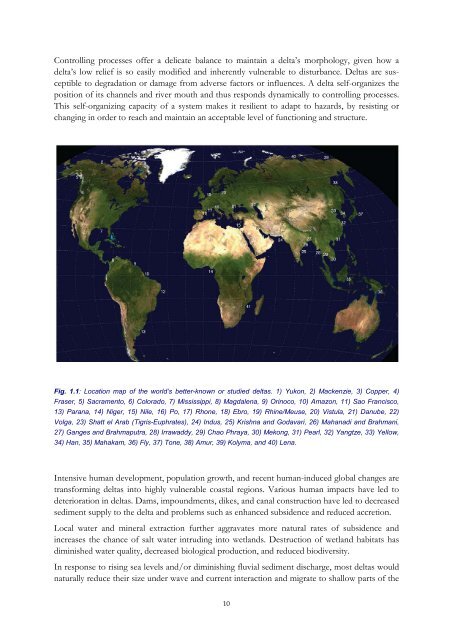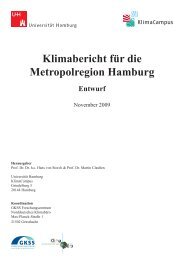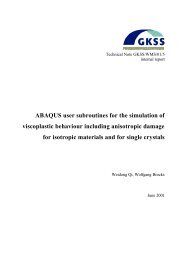Dynamics and Vulnerability of Delta Systems - loicz
Dynamics and Vulnerability of Delta Systems - loicz
Dynamics and Vulnerability of Delta Systems - loicz
You also want an ePaper? Increase the reach of your titles
YUMPU automatically turns print PDFs into web optimized ePapers that Google loves.
Controlling processes <strong>of</strong>fer a delicate balance to maintain a delta’s morphology, given how a<br />
delta’s low relief is so easily modified <strong>and</strong> inherently vulnerable to disturbance. <strong>Delta</strong>s are susceptible<br />
to degradation or damage from adverse factors or influences. A delta self-organizes the<br />
position <strong>of</strong> its channels <strong>and</strong> river mouth <strong>and</strong> thus responds dynamically to controlling processes.<br />
This self-organizing capacity <strong>of</strong> a system makes it resilient to adapt to hazards, by resisting or<br />
changing in order to reach <strong>and</strong> maintain an acceptable level <strong>of</strong> functioning <strong>and</strong> structure.<br />
Fig. 1.1: Location map <strong>of</strong> the world’s better-known or studied deltas. 1) Yukon, 2) Mackenzie, 3) Copper, 4)<br />
Fraser, 5) Sacramento, 6) Colorado, 7) Mississippi, 8) Magdalena, 9) Orinoco, 10) Amazon, 11) Sao Francisco,<br />
13) Parana, 14) Niger, 15) Nile, 16) Po, 17) Rhone, 18) Ebro, 19) Rhine/Meuse, 20) Vistula, 21) Danube, 22)<br />
Volga, 23) Shatt el Arab (Tigris-Euphrates), 24) Indus, 25) Krishna <strong>and</strong> Godavari, 26) Mahanadi <strong>and</strong> Brahmani,<br />
27) Ganges <strong>and</strong> Brahmaputra, 28) Irrawaddy, 29) Chao Phraya, 30) Mekong, 31) Pearl, 32) Yangtze, 33) Yellow,<br />
34) Han, 35) Mahakam, 36) Fly, 37) Tone, 38) Amur, 39) Kolyma, <strong>and</strong> 40) Lena.<br />
Intensive human development, population growth, <strong>and</strong> recent human-induced global changes are<br />
transforming deltas into highly vulnerable coastal regions. Various human impacts have led to<br />
deterioration in deltas. Dams, impoundments, dikes, <strong>and</strong> canal construction have led to decreased<br />
sediment supply to the delta <strong>and</strong> problems such as enhanced subsidence <strong>and</strong> reduced accretion.<br />
Local water <strong>and</strong> mineral extraction further aggravates more natural rates <strong>of</strong> subsidence <strong>and</strong><br />
increases the chance <strong>of</strong> salt water intruding into wetl<strong>and</strong>s. Destruction <strong>of</strong> wetl<strong>and</strong> habitats has<br />
diminished water quality, decreased biological production, <strong>and</strong> reduced biodiversity.<br />
In response to rising sea levels <strong>and</strong>/or diminishing fluvial sediment discharge, most deltas would<br />
naturally reduce their size under wave <strong>and</strong> current interaction <strong>and</strong> migrate to shallow parts <strong>of</strong> the<br />
10





